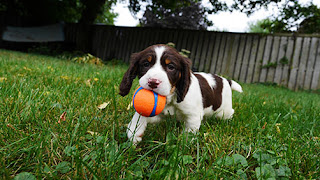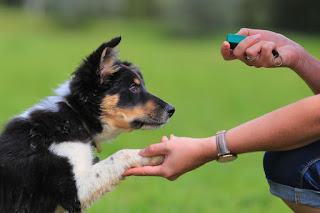How to choose your dog trainer or train your own?
Most dog owners know that it’s a lot easier to train dogs when they are younger, but they’re not really sure how to go about it and what they should look for when seeking out a trainer. Today, we’re going to talk about how (and when) you should go about getting your puppy professionally trained.
Ensure health first
Before seeking out any kind of training or classes, always make sure that your pup is up to date on his or her vaccinations and doesn’t have any other concerning health issues. The last thing you want to do is expose your dog — or other dogs — to potential illness or injury.
Start at the right time
While “the younger, the better” is largely true, there are still optimal times for seeking out training for your pup. For example, while regular training classes typically shouldn’t be started until your puppy is at least 6 months old, there are specific “puppy training” classes available for very young dogs. Your pup should enroll in this type of class from 8 to 16 weeks of age.
Must Have Bikejoring Equipment For Beginners
http://www.bigdogsport.com/must-have-bikejoring-equipment-for-beginners
Ask about certifications
While there are certainly plenty of great dog trainers out there who positively change the lives of their canine charges and their Pack Leaders without possessing any kind of formal certification, it’s still worth asking trainers if they have been certified.
There are all kinds of programs out there that will provide people with a “certification” paper simply for completing a paid class, so try to find a trainer who has met the requirements of the International Association of Canine Professionals (IACP), Certification Council for Pet Dog Trainers (CCPDT), or the International Association of Animal Behavior Consultants (IAABC).
If a trainer has a certification from one of these programs, you know that their abilities have been individually measured and that they have completed a significant number of training hours.
Demand humane methods
There are many philosophies about how best to train dogs, and it’s true that not all dogs are the same — while some are food-motivated, for example, others prefer play or affection. But most respected organizations agree that positive motivators that reward dogs for good behaviors are more effective for training than negative motivators that punish them for bad behaviors. This is especially true for training puppies, because most haven’t really had time to have any unwanted behaviors become ingrained.
If you notice a puppy trainer engaging any training techniques that involve hitting, scaring, or yelling at dogs, look elsewhere. You want someone who ignores unwanted behaviors, praises appropriate behaviors, and engages in calm, assertive corrections when necessary. Remember, a correction does not mean hitting a dog. It means redirecting or blocking them from an unwanted behavior. Most puppies will naturally gravitate toward acts that earn them rewards.
Dog Attack Protective Clothing: A Must Have For Dog Training
http://www.bigdogsport.com/dog-attack-protective-clothing-a-must-have-for-dog-training
See how you feel
A trainer may have years of experience and a successful track record, but if you don’t approve of their methods or feel comfortable working with them, you should probably look for someone else. Even if a trainer is detailing all of the things that you are doing wrong with your pup, they should be able to treat you respectfully and explain things in a way that’s easy for you to understand.
Additionally, good trainers will keep up with the latest in dog training methods and be able to tell you about what’s out there, adapt their methods to an individual dog’s needs, and have rules in place to protect dogs, such as requiring vaccinations — this last one is especially important for puppy classes!
Ultimately, there’s only so much you can do when picking a trainer for your pup. If you choose someone and then later feel like you made a mistake, don’t hesitate to seek help elsewhere. And if you’re unsure where to find good puppy trainers, talk to your vet or other pet owners you know for recommendations.
So what can you do to help your pup learn the game like a pro? Here are six tried and true tips.
1. Start with chasing
If your dog is of the “sit and stare” variety, your first goal is to teach him to chase after the object you want him to fetch. Generally speaking, there are three ways to do this, depending upon what motivates your pup: you can offer him affection, treats, or play for retrieving the chosen object.
Whichever motivator you use, the process is basically the same. Encourage your dog to go after the item you want him to fetch. When he grabs it, reward him with his motivator of choice, then take the object away. Repeat this a few times, then toss the object a short distance. When he goes for it, immediately reward him again. Repeat the process until you can reliably toss the object and get him to chase it.
Service Dog Mobility Harness: A Must-Have In Dog Training
http://www.bigdogsport.com/service-dog-mobility-harness-a-must-have-in-dog-training
2. Add extra motivation
Want to encourage her to give chase even more? Try holding her back after throwing the toy. She’ll naturally tug against you, especially if you offer verbal encouragement while still holding her back. Once you finally let go, she’ll be after the object like a rocket.
3. Retrieving
After your dog chases the object, the next step is getting him to actually bring it back to you. There are a number of different things you can do depending on your dog’s behavior. If he won’t bring the object back at all, it can help to use a second toy. Once he’s “caught” the first one, show him the second and throw it in the opposite direction. He probably won’t carry the first toy with him, but it will at least get him accustomed to the idea of running back to you after he’s caught the object.
After he masters this, try calling him to come back to you while he’s holding the object and asking him to drop it. If you show the second object, he’ll likely drop the first one to chase after it. Eventually, he’ll learn that if he comes back to you and drops the object, you’ll throw it again.
4. Avoiding “keep away.”
For dogs that like to catch the object and run off with it, a rope can help. Once she catches the object, wriggle the line and pull it towards you or run away from your dog with it. This should encourage her to follow you. Even if she doesn’t, reel the rope in and praise her when she gets close, then toss the object again and repeat. Do this for a few weeks and your pup should come to you naturally.
5. Getting the object back
If your dog stops and drops the object before reaching you, back away while saying “All the way,” or “Bring it.” Once he reaches the spot where you were originally located, go to him and offer praise, then toss the object again. If the issue is that he won’t let go, tell him to drop it and put a treat by his nose. Most dogs will drop the object to go for the treat.
6. Pick something your dog likes
Perhaps the most important rule of all — your dog isn’t going to chase after something unless she actually wants it, so feel free to experiment with different objects (balls, Frisbees, sticks) until you find one that she’s interested in.


Comments
Post a Comment